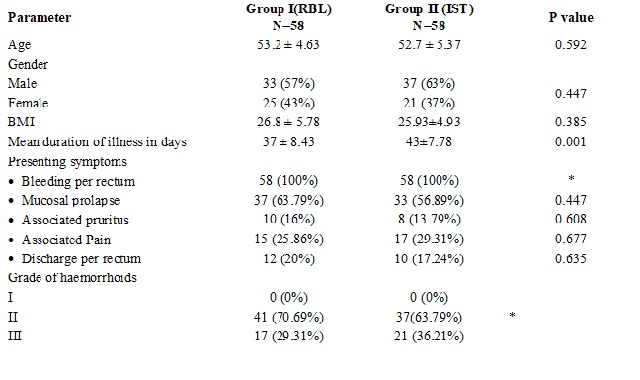Comparison of treatment outcome following rubber band ligation vs injection scleratherapy for treatment of hemorrhoids: a prospective observational study
Abstract
Background: Most common anorectal diseases seen in the community is hemorrhoids. The treatment aspect of each stage of hemorrhoids varies. Conservative treatment for first and second stages is preferred. Failure of conservative treatment and advanced diseases hasother options like sclerotherapy, ban ligation, cryosurgery and stapling. The objective of the present study is to compare treatment outcome of rubber band ligation and sclerotherapy in stage 2 hemorrhoid cases.
Methods: Prospective observational study including uncomplicated stage 2 hemorrhoids cases was conducted in department of general surgery, Velammal Medical College. Madurai. The study population was divided into two groups by random allocation treatment procedure of rubber band ligation or sclerotherapy was allotted. The study was conducted during March 2018 to December 2018.
Results: Total of 116 patients were included for analysis. The mean of group I was 53.2±4.63yrs and in group II was 52.7±5.37 yrs. The male and female distribution was almost similar in both groups. 41 of the group I patients and 37 of group II patients had stage 2 disease. 29% in group I and 36% in group II had stage 3 disease. In group I, 82.75% participants had complete recovery and 10.35% participants had partial recovery. In group II, 79.31% participants had complete recovery and 17.51% participants had partial recovery. The difference in the proportion of post-operative outcomes between study groups was statistically not significant. Comparison of pre and post-operative SS score between the two study groups was statistically significant.
Conclusions: Stage 2 and 3 hemorrhoids warranting OPD based interventional procedures were presented with almost similar set of symptoms. The rubber band ligation and injection sclerotherapy both had similar post treatment outcome. Based on the patient’s willingness and surgeons’ decision any method can be chosen for the benefit of the patient.
Downloads
References
2. Bailey H. Innovations for an Age-Old Problem: Hemorrhoids in the Female Patient. FEMALE PATIENT-PRACTICAL OB GYN MEDICINE THEN OB GYN EDITION. 2004;29(1):17-23.[pubmed]
3. Brown SR. Haemorrhoids: an update on management. Ther Adv Chronic Dis. 2017 Oct;8(10):141-147. doi: 10.1177/2040622317713957. Epub 2017 Jun 21.[pubmed]
4. Chugh A, Singh R, Agarwal P. Management of hemorrhoids. Indian J Clinic Pract. 2014;25(6):577-80.
5. Johanson JF, Sonnenberg A. The prevalence of hemorrhoids and chronic constipation. An epidemiologic study. Gastroenterology. 1990 Feb;98(2):380-6.
6. Gartell PC, Sheridan RJ, McGinn FP. Out-patient treatment of haemorrhoids: a randomized clinical trial to compare rubber band ligation with phenol injection. Br J Surg. 1985 Jun;72(6):478-9.[pubmed]
7. Thomson WH. The nature of haemorrhoids. Br J Surg. 1975 Jul;62(7):542-52.
8. Murie JA, Mackenzie I, Sim AJ. Comparison of rubber band ligation and haemorrhoidectomy for second- and third-degree haemorrhoids: a prospective clinical trial. Br J Surg. 1980 Nov;67(11):786-8.[pubmed]
9. Poen AC, Felt-Bersma RJ, Cuesta MA, et al. A randomized controlled trial of rubber band ligation versus infra-red coagulation in the treatment of internal haemorrhoids. Eur J Gastroenterol Hepatol. 2000 May;12(5):535-9.[pubmed]
10. Khan R, Itrat M, Ansari A, Zulkifle M. A study on associated risk factors for haemorrhoids. J Biol Sci Opinion. 2015;3(1):36-8.
11. Johanson JF, Sonnenberg A. Constipation is not a risk factor for hemorrhoids: a case-control study of potential etiological agents. Am J Gastroenterol. 1994 Nov;89(11):1981-6.[pubmed]
12. Rhee JC, Lee KT. The causes and management of lower GI bleeding: a study based on clinical observations at Hanyang University Hospital. Gastroenterol Jpn. 1991 Jul;26 Suppl 3:101-6.[pubmed]
13. Varma JS, Chung SC, Li AK. Prospective randomised comparison of current coagulation and injection sclerotherapy for the outpatient treatment of haemorrhoids. Int J Colorectal Dis. 1991 Feb;6(1):42-5.[pubmed]
14. Faucheron JL, Gangner Y. Doppler-guided hemorrhoidal artery ligation for the treatment of symptomatic hemorrhoids: early and three-year follow-up results in 100 consecutive patients. Dis Colon Rectum. 2008 Jun;51(6):945-9. doi: 10.1007/s10350-008-9201-z. Epub 2008 Jan 25.[pubmed]
15. Jensen DM, Jutabha R, Machicado GA, et al. Prospective randomized comparative study of bipolar electrocoagulation versus heater probe for treatment of chronically bleeding internal hemorrhoids. Gastrointest Endosc. 1997 Nov;46(5):435-43.[pubmed]
16. Chew SS, Marshall L, Kalish L, et al. Short-term and long-term results of combined sclerotherapy and rubber band ligation of hemorrhoids and mucosal prolapse. Dis Colon Rectum. 2003 Sep;46(9):1232-7.[pubmed]
17. Sagap I, Remzi FH. Controversies in the treatment of common anal problems. World J Gastroenterol. 2006 May 28;12(20):3146-54.[pubmed]
18. Acheson AG, Scholefield JH. Management of haemorrhoids. BMJ. 2008 Feb 16;336(7640):380-3. doi: 10.1136/bmj.39465.674745.80.[pubmed]
19. Bhuiya M, Rahman S, Ali A. Effectivity of injection sclerotherapy on early haemorrhoids reported to surgical outpatient department. JAFMC Bangladesh. 2010;6(2):25-7.
20. Greca F, Hares MM, Nevah E, et al. A randomized trial to compare rubber band ligation with phenol injection for treatment of haemorrhoids. Br J Surg. 1981 Apr;68(4):250-2.[pubmed]
21. Sim AJ, Murie JA, Mackenzie I. Three year follow-up study on the treatment of first and second degree hemorrhoids by sclerosant injection or rubber band ligation. Surg Gynecol Obstet. 1983 Dec;157(6):534-6.[pubmed]
22. Ambrose NS, Morris D, Alexander-Williams J, et al. A randomized trial of photocoagulation or injection sclerotherapy for the treatment of first- and second-degree hemorrhoids. Dis Colon Rectum. 1985 Apr;28(4):238-40.[pubmed]
23. Sim AJ, Murie JA, Mackenzie I. Comparison of rubber band ligation and sclerosant injection for first and second degree haemorrhoids-- a prospective clinical trial. Acta Chir Scand. 1981;147(8):717-20.[pubmed]
24. MacRae HM, McLeod RS. Comparison of hemorrhoidal treatment modalities. A meta-analysis. Dis Colon Rectum. 1995 Jul;38(7):687-94.[pubmed]
25. Iyer VS, Shrier I, Gordon PH. Long-term outcome of rubber band ligation for symptomatic primary and recurrent internal hemorrhoids. Dis Colon Rectum. 2004 Aug;47(8):1364-70.[pubmed]
26. Savioz D, Roche B, Glauser T, et al. Rubber band ligation of hemorrhoids: relapse as a function of time. Int J Colorectal Dis. 1998;13(4):154-6.[pubmed]



 OAI - Open Archives Initiative
OAI - Open Archives Initiative


















 Therapoid
Therapoid

